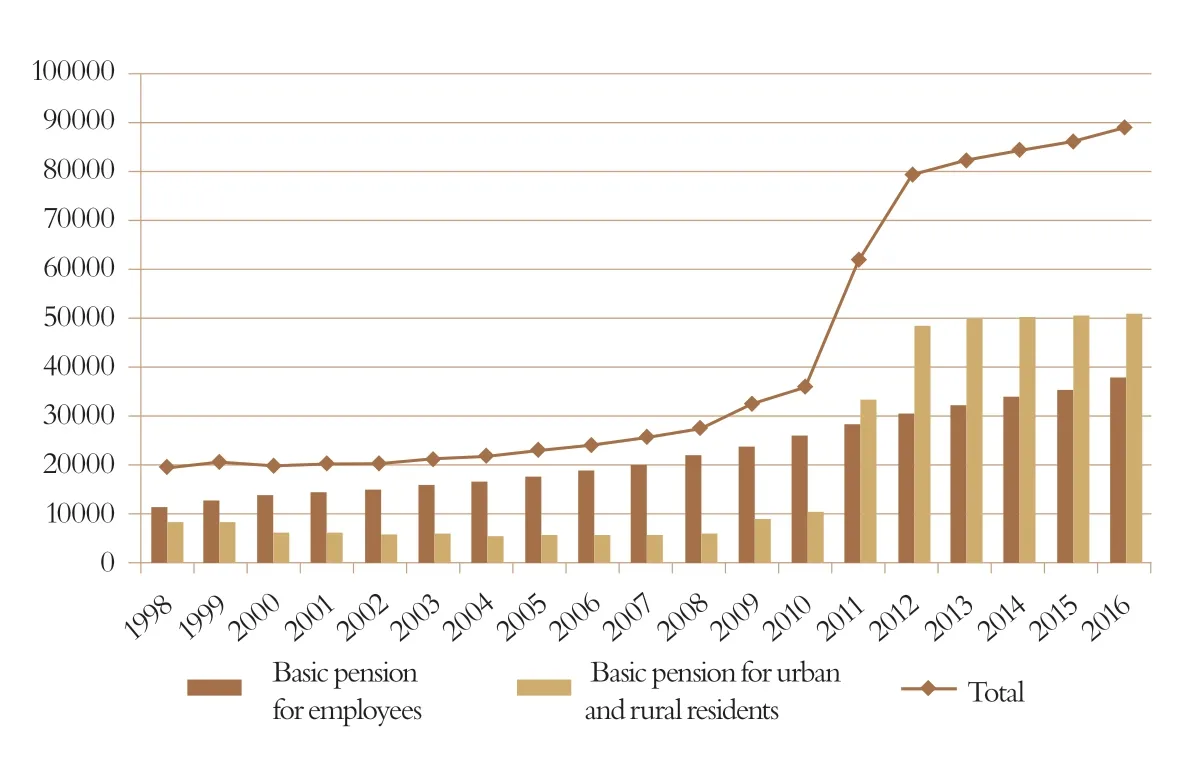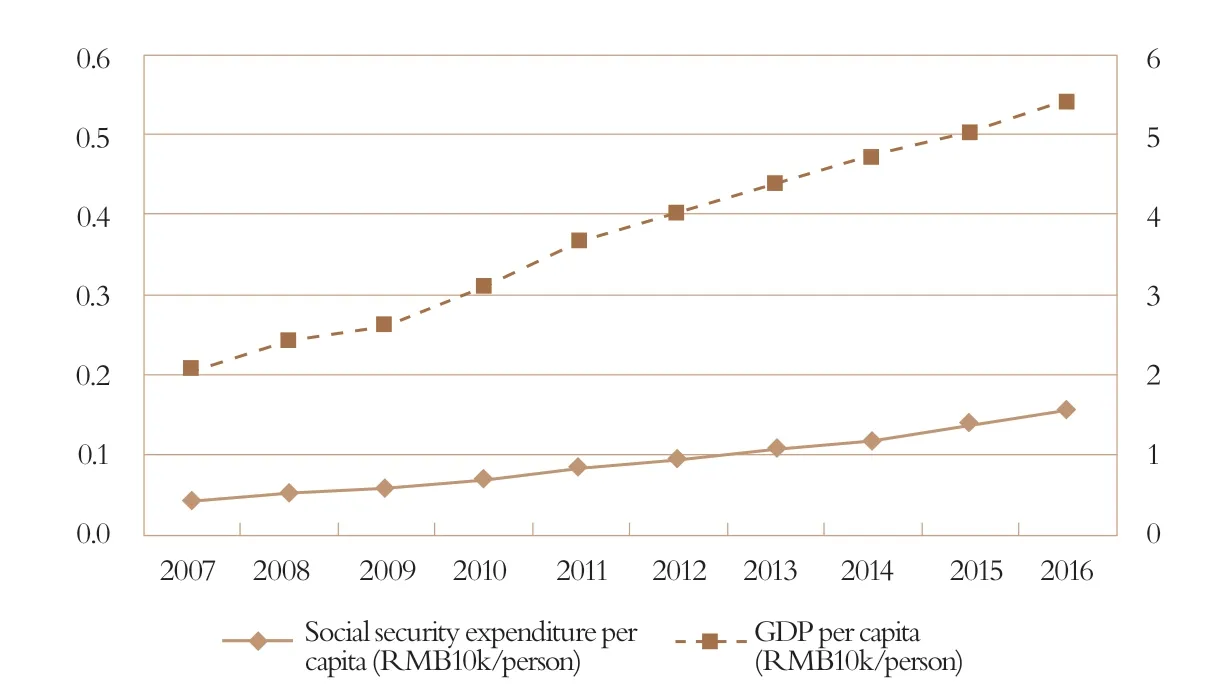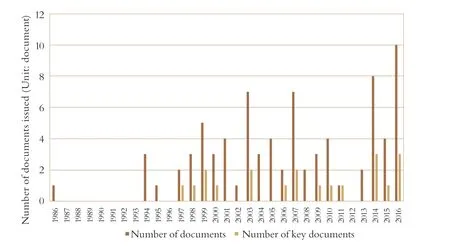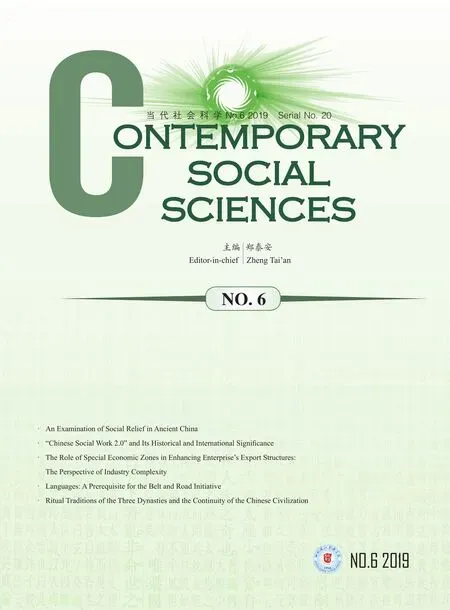The Social Security Miracle of China: Development Mechanism and Institutional Transformation
Lin Mingang
Abstract: In the rapid progress of China’s economic development and social security,economic development has led to a higher level of social security. Every economic crisis or economic adjustment has created the opportunity for improving social security. This paper argues that there is a “shock-response”relationship between economic development and social security and analyzes how social security changed from the passive response to the active response.Due to economic growth, the politics centering on people’s livelihood has promoted the full coverage of the social security system. The government investment in social security has been increasing, showing a new pattern of “middle-level economic growth and middle-level social welfare” and is helping to shift away from the previous “put welfare behind development”model toward simultaneous development and coordinated development.Creating a virtuous cycle of social security and economic development has become a key issue that China must face and need to solve on its way to become a strong country.
Keywords: social security, economic development, social security miracle, shock-response
Rapid Development of Both China’s Economy and Social Security
Since the beginning of reform and opening up, China’s economic development has achieved feats that have awed the world in what has been dubbed the “Chinese Miracle” (Wang, 2007). According to data released by the National Bureau of Statistics, in the period between 1978 and 2016 China recorded an average annual GDP growth rate of 9.6%, with the figure even rising to 10.36% if only corresponding data from the first ten years of the 21st century is considered. According to data from the World Bank, the Chinese economy’s contribution to the global economy expanded from 2.3%in 1978 to 14.9% in 2016. China overtook Japan as the second-largest economy in the world in 2010.China surpassed the United States and became the biggest trading nation in the world in 2013. Of course, rapid development in China is not limited to the economic sector.
Similarly, but even more surprisingly, it took China an even shorter period to create the “Chinese Miracle” in social security development. First, the establishment of systems and the implementation of projects. In terms of systems, the concept of “social security” was first put forth in 1986, and the target of creating a social security system to cover both urban and rural residents was formulated in 2007. This social security system emerged in its preliminary shape in 2013. In general, the work unitbased security model of the planned economy era became a thing of the past, and a social security mechanism framework that fit the market economy was established, which included social security,social aid, social benefits as foundation, basic pensions, basic medical care and a minimum standard of living system as focal points. Additionally, charitable endeavors and commercial insurance as supports were created. In terms of project progress, a simple glance at the changes in the number of basic pensions (Fig.1) and basic medical care insurance (Fig.2) participants is telling as the total number of participants in the basic pension system reached 888 million persons in 2016, which is 1.13 times larger and 99.8 million persons more than that in 2012. Second, the sheer number of people covered. As indicated by statistical data from the National Bureau of Statistics, following the continual rise in national fiscal budget investments into social security, the number of participants in various social security insurance programs in 2016 included 888 million persons in the basic pension program, more than 1.3 billion persons in the basic medical care program, 219 million persons in the workers’ compensation insurance program and 181 million persons covered by unemployment insurance. The world’s largest social security system with the largest coverage has been established,thereby cementing the bedrock of the social security endeavor of a strong country.
The massive scale, speed of developments and changes, and welfare coverage of Chinese social security are no doubt another “medal” on the trophy wall of feats achieved over the course of four decades of economic reform. In November 2016, the International Social Security Association (ISSA)recognized the Chinese government with the ISSA Award for Outstanding Achievements in Social Security to commend the monumental triumphs that China has accomplished in terms of expanding social security coverage in recent years (Bai, 2016, November 19).
Since the beginning of reform and opening up, China has transformed from one of the poorest nations in the world to the second-largest economy in the world, and the Chinese economic miracle has shocked and been lauded by the world. Looking back at this Chinese economic miracle, one can see that social security played crucial roles as a booster for economic expansion and a stabilizer for economic progress. Another fact is also evident. While Chinese social security accomplished these historic missions, it also garnered leapfrog progress. As such, this paper puts forth the Chinese“social security miracle” phenomenon, explores and discusses the influences of economic factors and political factors in the rapid advancement of social security, focuses on the interactive forces between economic development and social security in China, and at the same time analyzes how politics related to the livelihood of the people functions as a driving force behind the transformation and development of the social security institution.
Economic Development and Social Security: Shock-response
First, the development of social security hinges on the development of the economy, and social security development will also contribute to economic development. The essence of social security is the distribution of national income. The level of development of a nation’s social security is affected by a multitude of factors such as politics, population and social traditions, but is ultimately contingent upon the degree of economic development. A high or low level of economic development directly influences the standard of social security, and the economic development level also determines the scale and structure of the social security institution.
Given the mutual relationship between economic development and social security in the past ten years, changes in economic development and social security exhibit a positive correlation in their development trends, with economic development inducing clear improvements in social security, and social security level improving on the heels of economic expansion. Without economic foundation or increase in wealth, it would be impossible to carry out incremental reforms in social security. In this regard, the Chinese “economic miracle” engendered the Chinese“social security miracle”.
Second, social security has changed from passive response to active response. In 1986, over the course of China’s shift from a planned economy towards a market economy, the social security institution was born, and the concept of “social security”was mentioned for the first time in the 7th Five-year Plan for National Economic and Social Development.In 1993, social security was,for the first time, stipulated as“being extremely important to deepening reforms in enterprises and public institutions, maintaining social stability and successfully establishing a socialist market economic system” in the Decisions for Numerous Issues about Establishing a Socialist Market Economic System. Thus, social security was deemed one of the five major mechanisms comprising a socialist market economic system and was implemented as a type of economic policy.

Fig. 1 Number of Participants in the Basic Pension Program from 1998-2016 (Unit: 10,000 persons)
In 1997 the Asian financial crisis erupted to the dismay of the nations of Asia and the entire world.During this catastrophe, China had to deal with challenges from two aspects: First, the vast number of people laid off due to reforms in state-owned enterprises; second, how to invigorate the economy.
On the one hand, upon inception social security first became a support measure for state-owned enterprise reforms, helping to allay economic development pressures and fuel economic growth.In the Notification about Ensuring Basic Livelihood Security and Reemployment of Laid-off Workers of State-owned Enterprises issued in 1998, the “two assurances” and “three security lines” were proposed, the “two assurances” being the timely issuance of basic pensions in their full amounts to enterprise retirees and assuring the basic livelihood of laid-off workers of state-owned enterprises.The “three security lines” were basic livelihood security for laid-off workers of state-owned enterprises, unemployment insurance and a minimum standard of living for urban residents. These“three security lines” and “two assurances” were last-ditch efforts that contributed immensely to the last stage of a smooth transition during the peak period of state-owned enterprise lay-offs. Take the span between 1998 and the end of June 2002 as an example. There was a cumulative total of more than 26 million workers dismissed by state-owned enterprises, and over 90% of these people entered corporate reemployment centers. The number of retirees claiming basic pensions rose from 27 million to more than 32 million, with an average annual increase in 1.5 million retirees, and around 98% of retirees were given their pensions in full and in time, while RMB 21.5 billion in previously owed pensions was paid and approximately 95% of laid-off workers from state-owned enterprises, as in more than 30 million former employees, were given a basic allowance (Zheng, 2009). Specific and targeted social security policies enacted during this special period of economic development were able to effectively ensure the basic livelihoods of urban residents, maintain social stability, and promote smooth progressions in economic system reforms and economic structural adjustments, reinforcing China’s ability to overcome the significant drop in exports and lethargic economic growth after the country emerged from the East Asian financial crisis and laying the groundwork for the recovery and explosive expansion of the Chinese economy and the nation’s accession into the WTO (Wang, 2007).
On the other hand, during the Asian financial crisis, the Chinese government positioned civic wellbeing enhancement and social endeavor development as focal points in raising domestic demands and adjusting economic structures (Zheng, 2009, February 28) while at the same time, full-fledged growth was achieved over the course of social security establishment, which emboldened consumer confidence, increased purchasing power and instigated a shift in the economy from an export orientation toward a domestic demand-driven model. As such, in order to pivot from encouraging exports to stimulating domestic demands, social security policy was for the first time included in a stimulus package designed for domestic demand expansion and growth assurance, and also for the first time social security was combined with economic growth stimulation. At the same time,fiscal budget allocations for aspects such as healthcare, senior care and social aid clearly increased, and the establishment of a social security institution was given a high priority.
In 2007, the subprime mortgage crisis emerged in the United States,which subsequently spiraled into a full-spectrum financial crisis on a global scale. The Chinese government had learned from its experience in effectively dealing with the Asian financial crisis of 1997 and positioned the functionality of social security as one of the primary measures to counter the international financial crisis.
This paper organized a total of 80 national-level social security laws, regulations and documents created between 1986 and 2016, of which 26 were considered important.①This paper defines key social security laws, regulations and documents as national-level laws, regulations and documents related to the construction of social security system, such as the Social Insurance Law issued in 2010 and Opinions of the CPC Central Committee and the State Council on Deepening Medical and Health System Reforms in 2009.From Fig. 5 it can be seen that between 1986 and 1993, as in the period before the concept of social security was proposed and before the holistic promotion of the creation of a socialist market economy, almost no social security laws, regulations or documents were issued. Between 1994 and 1996, a total of four social security laws, regulations and documents came into existence. The Asian financial crisis in 1997 was a tipping point, and the span from 1997 to 2002 was the first high concentration period for the unveiling of social security laws, regulations and documents, with a total of 18 laws, regulations and documents promulgated, five of which were important. The nationwide SARS epidemic occurred between 2002 and 2003, ushering in China’s second high concentration period for the unveiling of social security laws, regulations and documents between 2003 and 2006, with a total of 16 laws, regulations anddocuments promulgated, five of which were important. The international financial crisis in 2007 was yet another tipping point, signifying the country’s third high concentration period for the unveiling of social security laws, regulations and documents.Thereafter, the construction of the social security system in China entered the expansion and development phase, and a preliminary social security system with urban and rural coverage took shape.

Fig. 2 Number of Participants in the Basic Medical Care Insurance Program from 2000-2015 (Unit: 10,000 persons)
Reviewing the performance of social security during the two economic crises and the related economic policy adjustments, first and foremost, Chinese social security functioned as a social policy that responded to the needs of society, and maintained the stability and security of society by safeguarding the basic livelihoods of inhabitants during the economic crises and economic reforms.Furthermore, by fairly doling out various material assistance and service facilities to members of the society, social security enabled these society members to share the fruits of economic progress and social advancement, which mitigated the social pressures arising from the Chinese economic reforms, transformations and upgrades, and propelled economic expansion. Second, social security was considered as an economic policy and functioned as an economic measure that responded to the needs of economic development. As a method to invigorate the economy, social security was closely associated with economic growth, deemed pertinent to increasing employment and expanding domestic demands, and contributed vastly to driving consumption and spurring economic recovery. The “shock-response” model exists between economic development and social security.Each economic crisis or major economic change also created an opportunity for social security development, a window for social security’s own expansion, and directly stimulated the efficacy of the function of social security.

Fig. 3 GDP Per Capita and Social Security Expenditure Per Capita in China from 2007-2016
Livelihood Policies Promoted the Transformation and Development of Social Security
Ever since China increased the pace of its pivot toward a socialist market economy in the mid-1990s,its economy has registered sustained and rapid growth, wealth in society increased drastically, and the country has possessed the capacity to address basic livelihood issues and to raise the welfare of its citizens. As China entered its social policy era (Wang, 2004), the “historic leap from economic policy to social policy” has been achieved (Wang, 2007). In particular, the “putting people first” concept adopted since 2010 is the core of the Scientific Outlook on Development, and to uphold scientific development we should attach greater importance to “putting people first” and ensuring and improving the people’s wellbeing, with the latter as the fundamental starting point and initial step in hastening adjustments in the economic development model. Politics related to people’s livelihood has become the new nexus of Chinese politics, which stresses the civic wellbeing development objectives that all the people enjoy their rights to education, employment, medical and old-age care, and housing.
In 2010, the Proposal of the CPC Central Committee for Formulating the Twelfth Five-Year Plan for National Economic and Social Development proposed that social security development needs to adhere to broad coverage, basic insurance, multiple levels and sustainability, widespread coverage,basic necessity assurance, a multi-tiered model and sustainability, and to expedite the establishment of a social security system that covers both urban and rural residents. The Social Insurance Law of the People’s Republic of China issued on October 28, 2010, listed “broad coverage, basic insurance,multiple levels and sustainability, widespread coverage, basic necessity assurance, a multi-tiered model and sustainability” as the basic orientation of the social security institution of China. In June 2011, the Ministry of Human Resources and Social Security released the Outline for Human Resources and Social Security Development Plan for the 12th Five-year Plan, which proposed full institutional coverage of new social pension security for rural villages and social pension security for urban residents between 2011 and 2015. In November 2012, the political report to the 18th National Congress of the CPC clarified the social security development direction of “widespread coverage, basic necessity assurance, multi-tiered model and sustainability,” signifying that the Chinese institution for social security had entered a critical phase for advancing “full coverage”. At the same time, the social security institution and its policies were being improved and consolidated,allowing the construction of the social security institution to accelerate its growth.
Over the present course of building a moderately prosperous society in all respects, the “peoplecentered” governing principles with “regard the benefit of the people as their highest career accomplishment” was proposed,indicating that the statecraft of China has switched from prioritizing economic development to the improvement and upliftingof the happiness and wellbeing of the people. As the tempo for establishing a prosperous society quickens, people harbor new expectations and demands for a better life. “People love life and yearn for better education, more stable jobs, more satisfactory income, greater social security benefits, better medical and health services, more comfortable living conditions and a more beautiful environment. They want their children to grow up well and have better jobs and more fulfilling lives. We must take the people’s yearning for a better life as the goal of our struggle” (Xi, 2016). The government is motivated to further amend fiscal budget expenditure structures and to allot more fiscal budget funding toward education, employment, medical care, social security, public safety and other public service sectors so that the feats of public services may more extensively and fairly benefit all members of society including population groups in difficult circumstances.

Fig. 4 Fiscal Budget Expenditures and Social Security Expenditures Per Capita in China from 2007-2016

Fig. 5 Issuance of Laws, Regulations and Documents Pertaining to Social Security in China from 1986-2016
Realization of a Benign Cycle of Social Security and Economic Development
At present, social security reforms in China are heading in a direction that includes continually intensifying the responsibility of the government, thoroughly enlarging the coverage of social security, steadily enhancing various social security benefits, and strengthening the construction of a social service system. The current state of social security in China exhibits a new development pattern characterized as “middle-level economic growth, middle-level social welfare”, and actions have been taken to explore a shift away from the previous “put welfare behind development” model toward simultaneous development and coordinated development. Seeking a benign cycle of social security and economic development has become a key issue that China must face and need to solve on its way to become a strong country.
In terms of the experience accumulated over the long-term interaction between social security and economic development in China, one objective is the continual fortification of social security’s orientation as an economic policy that can impart emphatic and stimulating effects on economic development. A second objective is that the social policy advantages of social security will be used to invigorate both individuals and society to promote shared development and to rely on social development to support sustainable economic development.
First, from the view of the economic performance of social security, social security should be considered an investment in society and a pathway to enhance key factors in production and steps should be taken to consolidate social security with other economic policies to generate developmental synergy.Active social security is to consider investments in social security as investments in human resources.For instance, social expenditures in healthcare and education possess economic benefits, and in the same light, social transfer payments for pensions and social security are not only contributive to income balance or redistribution, but also conducive to augmenting the quality of employment. Revolving around the concept of social investments, an active social security program includes active children development policies, adult employment policies and senior security policies. Early empowerment from childhood entails a “good start”, good medical care and good health, and quality education to children. At the same time, it is important to underscore more personalized employment services and skills training and replace the reliance of the unemployed on cash with capacity building. For elderly people, an active old-age strategy should be employed to intensify the re-development of senior human resources, increase social services and care for the elderly, and maximize the stimulation of labor resources in this segment of the population. Active social security places a bigger emphasis on building capacity in people and awakening the innate sense of responsibility, reorients state policy’s focus on “incremental” accumulation toward more interest in the acquirement of “quality” and “capacity”, which would be beneficial to raising the“existing quantity” of labor power in human capital in the market, while at the same time optimizing the“flow” of labor during different stages in life (Hemerijck & Vandenbroucke, 2012).
Investing in human capital to cement employment ability and lifting employment levels, and supporting the liquidity in the labor market and adopting flexible security mechanisms mean that social security possesses “prevention-centric” and “upstream action” characteristics, which largely replace traditional post-crisis rectification and redistribution mechanisms. Such a social security institution can help people plan and prepare for risks, stimulate the release of potential consumption demands by stabilizing projected income, and ultimately steer China toward becoming a major consumer nation. In this regard, social security can prolifically promote economic growth, and assist in the thorough transformation of economic development (Lin, 2016).
Second, from the point of view of the social aspect of social security, social security should engender equality and justice in society, elevate the wellbeing of the people, invigorate energy in both individuals and society, and realize shared development across society. There is no doubt that a market economy will disrupt the original distribution of interests, and the outcomes will be differences in the distribution of social resources and wealth, as well as the division of diverse interests among the members of society, which will be manifested as diversification in the interests pursued and appearance of conflicts of interests. Social security is a tool for state governance, and can be utilized to regulate income disparity and improve income distributions to provide stable and safe anticipations for everyone, alleviate the worries and anxieties among low-and-middle-income groups foster a positive social mindset, and achieve inclusive development in society.
In terms of development pathways, it is necessary to both continually elevate the level of social security and maintain control over the challenges for inflexible changes in the rise of socials security cash payments. A possible solution is to alter social security’s long-standing “cash over service”orientation in its payment structure and transcend the insurance model of traditional welfare nations-income maintenance programs. Through inclusive social services, continually investing social resources into the stimulation of labor, aids for children and families, protections for special population segments and other social service sectors, so as to invigorate energy in both individuals and society, we can establish a nation of social services, and formulate a social security model with Chinese characteristics (Lin, 2016).
In terms of visions for development, from the perspective of the holistic development of China,social development and economic development ought to be viewed as two sides of the same coin,and a new structure where the two sides continually support each other should be created. Through transformations in the social security institution, we should seek a beneficial cycle of social security and economic development in order to fuel the sustainable development of China on a higher level.
 Contemporary Social Sciences2019年6期
Contemporary Social Sciences2019年6期
- Contemporary Social Sciences的其它文章
- The Role of Special Economic Zones in Enhancing Enterprise’s Export Structures: The Perspective of Industry Complexity
- Measurement of Urban Economic Gravity of China’s Three Major Agglomerations and Its Implications for the Coordinated Development of the Beijing-Tianjin-Hebei Region
- A Brief Introduction of Sichuan Academy of Social Sciences
- A Brief Introduction to the English Periodical of Contemporary Social Sciences
- Requirements for contribution
- A Critical Analysis of the Legality of Fan-subbing in Copyright Law
